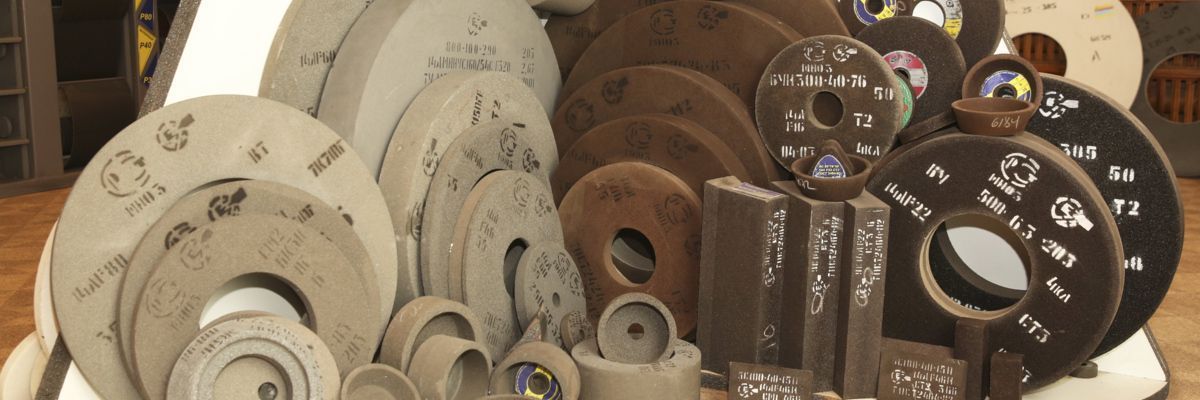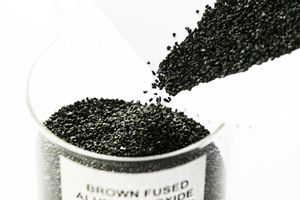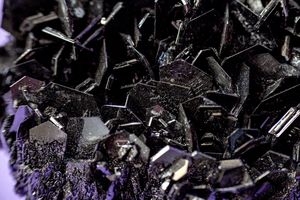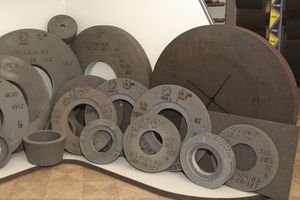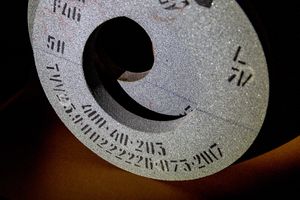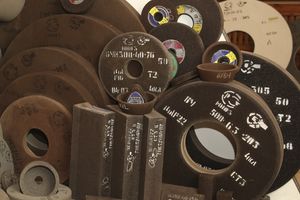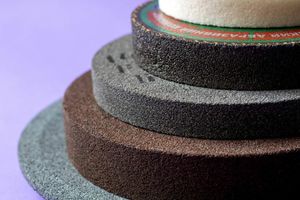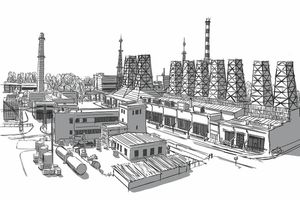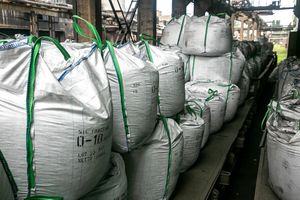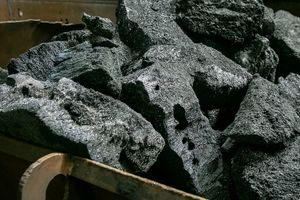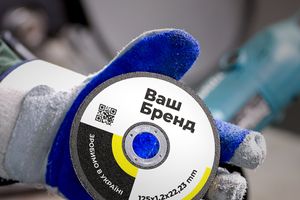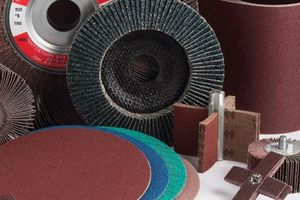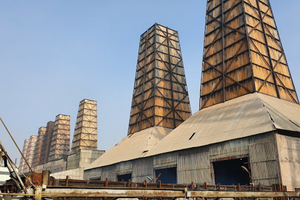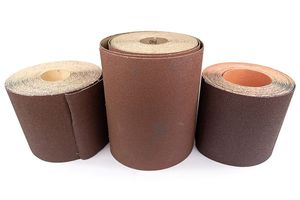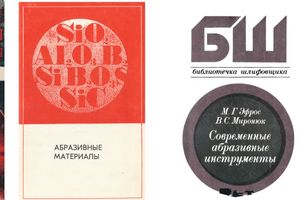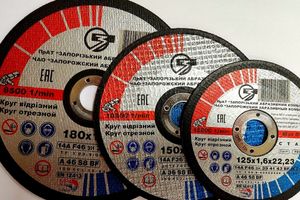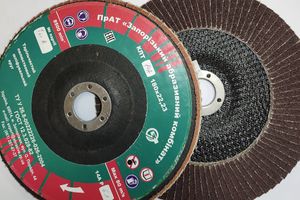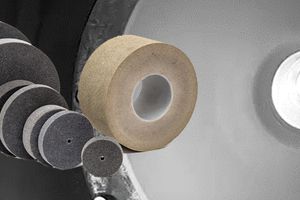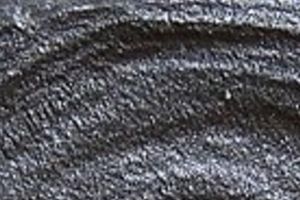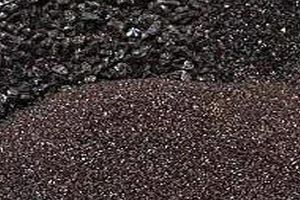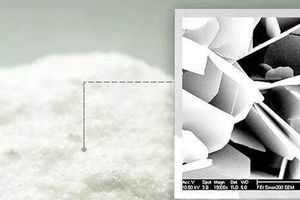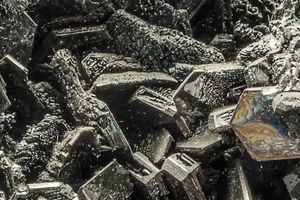When choosing a bond for an abrasive tool, it should be taken into account that each type of bond has its own characteristics and advantages, which determines the cutting properties of the tool, and, consequently, its scope of application.
The advantage of an abrasive tool with a bakelite bond is its high strength and sufficient elasticity, which allows it to be used under shock loads (grinding and stripping operations).
The high bending strength allows the use of bakelite bonded wheels for cutting operations under conditions of high lateral loads and allows the production of thin cutting wheels (less than 3 mm in height).
The high strength of the bakelite bond allows working at high cutting speeds. Thus, circles on a bakelite bond, reinforced with glass mesh, operate at a peripheral speed of up to 80 m/s.
Bakelite bonded wheels provide a higher surface roughness class. In addition, it is advisable to use an abrasive tool with a bakelite bond when processing thin products, blades of cutting tools and other parts where burning is not allowed.
Of great importance for the efficiency of the grinding process is the correct choice of characteristics of the abrasive tool for specific conditions of abrasive processing. The characteristics of an abrasive tool, which determines its operational properties, in addition to the type and size, include the type and grain size of the abrasive material, hardness, structure number and type of bond, etc. All these parameters determine the operational characteristics of the tool, so their correct choice is the most important condition for ensuring the level and stability of the cutting properties of the abrasive tool for the consumer.
In this case, it is necessary to take into account the grinding conditions: the machine, its operating modes, the brand of the material being processed, the processing allowance, the required surface roughness, the type and nature of the feed, the cutting fluid, the method and tool for dressing the grinding wheel, etc.
Part size and shape of sanded surface
To process parts that have a large mass, which effectively removes the heat generated during grinding, harder wheels and intensive modes are used.
Products with small wall thickness are treated with soft circles of open structures.
With a large contact area between the grinding wheel and the product, softer wheels are required, since the specific pressures may be small for periodic renewal of the wheel surface, and with a small contact area, vice versa.
Grinding of discontinuous surfaces should be done with harder wheels of a dense structure, since the discontinuity of the surface contributes to the self-sharpening of the wheels. In the case of processing products with the end of a wheel with large contact between the surface being processed and the abrasive tool, softer coarse-grained wheels are required than in the case of processing with the periphery of the wheel. In this case, ring circles should be softer than segment ones.
To ensure the required profile, shaped grinding is carried out with harder and relatively coarse-grained wheels. For uneven, discontinuous surfaces (castings, investments, parts with protrusions, grooves), for small contacts and work involving impacts, hard wheels with a dense structure should be used.
Grinding allowance
The size of the allowance determines the nature of the abrasive processing operation: roughing, preliminary, finishing and final grinding.
To remove large allowances during roughing and preliminary grinding operations, coarse-grained wheels with an open structure are used. For rough grinding, medium-hard and hard wheels are used.
During finishing operations, when small allowances are removed from workpieces, it is recommended to use relatively fine-grained wheels with a denser structure.
Machine
The choice of grinding wheel is significantly influenced by the type, power and condition of the machine on which the grinding operation is performed. With high machine power, you can use more intense and productive grinding modes and use harder abrasive tools. The use of cooling on grinding machines greatly facilitates the grinding process. Cooling helps to reduce the heating of the workpiece, remove chips and reduce their sintering, as well as reduce clogging of the working surface of the wheel. Therefore, when using coolant, harder wheels are used.
Operating mode
The operating mode of the machine is of no small importance for choosing an abrasive tool.
With an increase in the peripheral speed of the wheel, the number of abrasive grains involved in the grinding process per unit time increases, and consequently, the cross-section of the chip and the magnitude of the load per grain decrease. Thus, the abrasive grains wear less. On the contrary, as the wheel speed decreases, fewer grains are involved per unit time, the load on them increases, and the wheel wears out faster. In this case, harder wheels should be used.
Working at the maximum wheel speeds allowed by the conditions of its strength and the type of machine allows you to increase grinding productivity.
Increasing the cross-feed speed and increasing the depth of cut leads to more intensive wear of the grinding wheel.
Intensification of grinding conditions often leads to deterioration in the quality of the machined surface and the appearance of burns.
Abrasive material
The choice of abrasive material for the manufacture of tools is determined by the characteristics of the material being processed.
Tools made of electrocorundum are used when processing materials with high tensile strength (steel, ductile iron, iron, brass, bronze).
Silicon carbide tools are used for processing materials with low tensile strength, high hardness and brittleness (hard alloys, cast iron, granite, porcelain, glass, ceramics), as well as very viscous materials (heat-resistant steels and alloys, copper, aluminum, rubber).
Grain
The grain size is selected depending on the following factors:
- Amount of material removed during processing;
- Required class of roughness and precision of surface treatment;
- Properties of the processed material;
Coarse-grained tools are used:
- During roughing and preliminary operations with large depths of cut, when large allowances are removed;
- When working on machines of high power and rigidity;
- When processing materials that cause the pores of the wheel to fill and its surface to become greasy, for example when processing brass, copper, aluminum;
- When there is a large area of contact between the wheel and the workpiece, for example when using high wheels, when flat grinding with the end of the wheel, when internal grinding.
Medium-grained and fine-grained tools are used:
- To obtain a surface roughness of 0.32...0.08 microns
- When processing hardened steels and hard alloys;
- For final grinding, sharpening and finishing of tools;
- With high requirements for the accuracy of the processed part profile.
Hardness
Tool hardness largely determines the performance of the machining process and the quality of the machined part.
Abrasive grains, as they become dull, must be renewed by chipping and crumbling particles.
If the wheel is too hard, the bond continues to hold grains that have become dull and have lost their cutting ability. At the same time, a lot of power is consumed, the products heat up, traces of crushing, risks, burns and other defects appear on the surface. If the wheel is too soft, the grains that have not lost their cutting ability become chipped, the wheel loses its correct shape, and its wear increases. Thus, in both cases, the intensity of the grinding process decreases and the roughness of the workpiece increases.
When choosing the hardness of an abrasive tool, you should be guided by the following provisions:
1. Hard materials are more likely to wear out abrasive grains and dull them. Removal of dull grains is more likely to occur in relatively soft circles.
Therefore, soft abrasive tools should be used to process hard materials, and harder ones should be used to process materials of low hardness. The exceptions are copper, aluminum, lead, stainless and heat-resistant steels, which are ground with a soft tool.
When processing viscous materials, grinding waste fills the pores of the wheel, and it becomes unsuitable for work. In this case, it is necessary to edit the wheel, although the abrasive grains may still be very sharp.
2. With an increase in the contact area between the wheel and the product, the pressure per unit area of the wheel decreases, and, therefore, the renewal of dull grains becomes more difficult. In this case, you should use a softer tool.
3. The greater the peripheral speed of the circle, other conditions being constant, the softer the tool should be used. For intensive operating conditions - at high product speed and transverse feed - harder wheels are used.
4. For preliminary operations, harder tools are used than for finishing operations.
5. When dry grinding, softer wheels should be used than when working with cooling.
6. When sanding uneven, discontinuous surfaces, harder tools are used than when sanding smooth surfaces.
7. On automatic machines of stable and rigid designs with a quiet spindle running, softer circles are used than on machines with manual feeds.
8. Fine-grained tools should be relatively less hard, and coarse-grained tools should be of greater hardness.
9. When sharpening the blades of hardened tools, when grinding and sharpening plates made of hard alloys, when processing the surfaces of products that do not dissipate heat well, thin ones, with holes (such as pipes), etc. Use soft grinding wheels.
10. Under the same grinding conditions, abrasive tools with a bakelite bond should be two degrees harder than tools with a ceramic bond.
11. Soft wheels are more economical than hard ones, since they are adjusted less frequently and allow processing with more intensive conditions. However, their hardness should not be so low that they quickly wear out and lose their shape.
Structure
The following factors influence the choice of tool structure:
- physical and mechanical properties of the material being processed (soft materials with low tensile strength are processed with circles of open structures, hard and brittle materials - with circles of closed structures);
- the required quality of finishing (for finishing processing, wheels of more closed structures should be used than for preliminary and rough processing; for roughing with a significant allowance, it is recommended to use wheels of open structures);
- the amount of pressure during grinding (at high pressures, wheels of medium and closed structures should be used).
